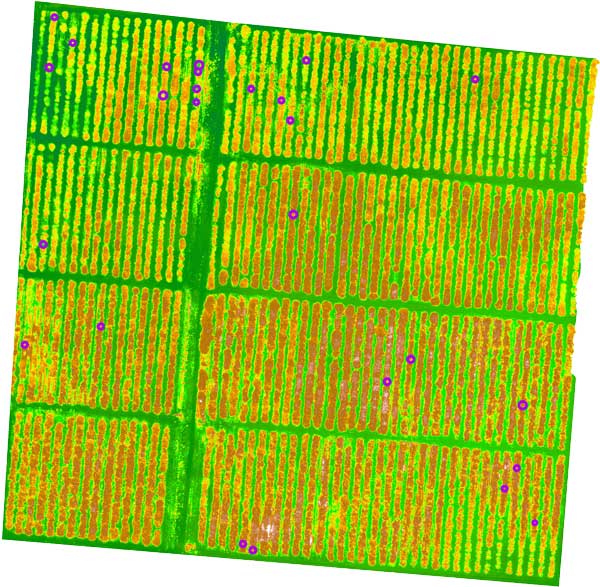Vegetation Indices
Benefits of measuring Vegetation Indices
- Crop Health Assessment: Vegetation indices, such as the Normalized Difference Vegetation Index (NDVI) or Enhanced Vegetation Index (EVI), provide valuable information about the health and vigor of crops. By measuring these indices, farmers can assess the overall vegetation condition, detect stress or nutrient deficiencies, and make informed decisions regarding irrigation, fertilization, or pest control. This helps optimize crop management practices and maximize yields.
- Environmental Monitoring: Vegetation indices are widely used in environmental monitoring to assess ecosystem health, land cover changes, and biodiversity. By measuring these indices over time, researchers can track vegetation dynamics, identify areas of deforestation or habitat degradation, and monitor the impact of climate change on ecosystems. This information is crucial for conservation efforts, land management planning, and understanding the Earth’s overall health.
- Remote Sensing Applications: Vegetation indices play a vital role in remote sensing applications. By analyzing satellite or aerial imagery and calculating vegetation indices, scientists can map and monitor vegetation patterns over large areas. This data is used for land cover classification, vegetation mapping, and monitoring vegetation growth trends. It helps in assessing the impact of natural disasters, monitoring agricultural productivity, and supporting land management decisions.
Save
By measuring vegetation indices, give importance to the health of your farm and gain unparalleled insights from it.

Best time to measure Vegetation indices
- Peak Growing Season: Measuring vegetation indices during the peak growing season provides a comprehensive assessment of vegetation health and vigor. This is when plants are actively photosynthesizing and experiencing maximum growth. By measuring indices such as NDVI or EVI during this time, you can obtain accurate information about the overall health and productivity of the vegetation.
- Pre- and Post-Management Activities: Measuring vegetation indices before and after management activities, such as fertilization, irrigation, or pesticide application, can help evaluate the effectiveness of these interventions. By comparing the indices before and after the management activities, you can assess the impact of these practices on vegetation health and make necessary adjustments to optimize their effectiveness.
- Seasonal Changes: Measuring vegetation indices at different points throughout the growing season allows for monitoring seasonal changes in vegetation health. This can help identify patterns, such as growth stages, stress periods, or phenological shifts, which are valuable for understanding the dynamics of the vegetation and making informed management decisions.
An example of ASAgro's reports in the field of Vegetation indices

The purple circles in this image indicate plants at risk and diseased in this agricultural field
1 of 1Frequently Asked Question
We utilize a combination of field measurements, remote sensing technologies, and advanced algorithms to measure vegetation indices. Field measurements involve collecting spectral data using handheld devices or sensors mounted on drones. Remote sensing technologies, such as satellite imagery, provide broader coverage and allow for monitoring vegetation indices over large areas. Our advanced algorithms process the collected data to calculate indices like NDVI or EVI, providing accurate and reliable measurements.
The frequency of vegetation index measurements depends on various factors, including crop type, growth stage, and management practices. Generally, it is recommended to measure vegetation indices regularly throughout the growing season to monitor changes in vegetation health. This could involve weekly or bi-weekly measurements, especially during critical periods such as planting, flowering, or fruiting. However, the specific frequency can be tailored to your specific needs and objectives.
What Our Clients Say About Us
Contact Us
info@asauas.com
- Sharjah Media City, Sharjah, UAE
- (+971) 504 766 075

